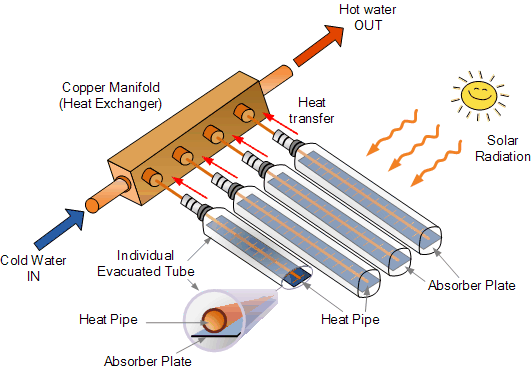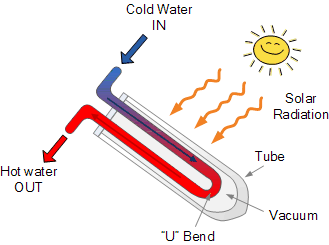Introduction
Renewable energy is the key for the planet’s existence in the future. The fossil fuels are non-renewable and require finite resources, which are dwindling because of high cost and environmentally damaging retrieval techniques. Climate change is real. Global warming is real. It took some time to accept this hard fact, but now with the realization, production of clean energy has become the primary goal of countries across all continents.
Great amount of research is carried in improving the efficiency of renewable energy and making it inexpensive. The main objective is to minimize or eliminate the usage of electricity produced by burning of coal which leaves behind large amounts of CO2. Solar Powered houses is the solution to this problem. One of the key components of this being the solar water heater.
Need
The conventional solar water heaters used flat-plate collectors with water as the heat-transfer fluid. These type of collectors are less efficient. This is owing to the heat losses in the form of convection and radiation. The simple fundamental to increase the efficiency is to decrease the heat losses. We know that convection requires material medium. So,if there is no material medium, there won’t be convection and thus, heat losses would be only due to radiation. This is the basic idea behind evacuated tube collectors. Solar water heating systems using vacuum tubes made of borosilicate glass with special coating to absorb the solar energy are called as Evacuated Tube Collector system (ETC Systems).
Working
Air between the two glass tubes is evacuated. It results in high level vacuum which acts as insulation and minimizes heat loss from the inner tube. The black coating in the inner tube absorbs the solar energy and transfers it to the heat transfer fluid.

An evacuated tube collector can achieve high temperatures in the range of 350K-450K, and work very efficiently. Although, they are more expensive than the flat plate collectors, the return would be greater for ETCs. There are a few different vacuum tube configurations, single wall tube, double wall tube, direct flow, heat pipe, and these differences can determine how the fluid is circulated around the solar hot water panel.
In heat pipe ETC, a heat pipe is connected to an absorber plate inside a vacuum sealed tube.

The heat pipe is hollow and is evacuated. Inside the heat pipe is small quantity of heat transfer fluid like alcohol with some additives. The heat pipe is connected to a manifold. Vacuum enables the liquid to boil at lower temperatures. The hot vapour rises and heats the heat pipe which heats the manifold. The fluid flowing through manifold picks up the heat. The connection between absorber and manifold is dry and thus can be easily setup and replaced.
In direct flow ETC, two pipes run through the vacuum sealed tube.

The fluid to be heated directly flows through these pipes and heats up. The arrangement is similar to flat-plate collectors, with the addition of evacuated tubes. Since the fluid flows into and out of each tube, it cannot be easily replaced.
The need was to minimize heat losses through convection and what better way can be, than to stop it completely from happening. The application of the simplest of concepts of eliminating convection by getting rid of the material medium itself has led to major improvements in this field as the efficiency has risen manifold.The understanding of fundamental sciences has provided one of the biggest leaps in the effort of making renewable energy efficient and inexpensive.
